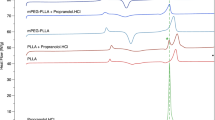Abstract
Traditional drug delivery systems that are based on multiple dosing are usually accompanied by many shortcomings, including unwanted fluctuations in the plasma concentration of the drug and poor patient compliance. In this study, we aimed to synthesize a polymeric drug delivery system based on a triblock copolymer of PLGA–PEG1000–PLGA and investigate its application as a controlled drug delivery system. Naltrexone hydrochloride and vitamin B12 were used as model drugs here. The copolymer was successfully synthesized by the ring-opening method. A phase transition analysis indicated that the copolymer is in gel at body temperature. The release profiles from the formulations showed a higher initial release followed by a slower pattern for up to 4 weeks. More than 50 % of the vitamin B12 and 60 % of the naltrexone hydrochloride were released during this period.






Similar content being viewed by others
References
Hatefi A, Amsden B (2002) Biodegradable injectable in situ forming drug delivery systems. J Controlled Release 80(1–3):9–28
Packhaeuser CB, Schnieders J, Oster CG, Kissel T (2004) In situ forming parenteral drug delivery systems: an overview. Eur J Pharm Biopharm 58(2):445–455
Ruel-Gariépy E, Leroux J-C (2004) In situ-forming hydrogels—review of temperature-sensitive systems. Eur J Pharm Biopharm 58(2):409–426
Jeong B, Kim SW, Bae YH (2002) Thermosensitive sol–gel reversible hydrogels. Adv Drug Deliv Rev 54(1):37–51
Khodaverdi E, Rajabi O, Abdekhodai MJ, Wu XY (2008) Heterogenous composite membranes as pH responsive drug delivery systems. IJBMS 11(2):70–79
Zentner GM, Rathi R, Shih C, McRea JC, Seo M-H, Oh H, Rhee BG, Mestecky J, Moldoveanu Z, Morgan M, Weitman S (2001) Biodegradable block copolymers for delivery of proteins and water-insoluble drugs. J Controlled Release 72(1–3):203–215
Qiao M, Chen D, Ma X, Liu Y (2005) Injectable biodegradable temperature-responsive PLGA–PEG–PLGA copolymers: synthesis and effect of copolymer composition on the drug release from the copolymer-based hydrogels. Int J Pharm 294(1–2):103–112
Chen S, Singh J (2008) Controlled release of growth hormone from thermosensitive triblock copolymer systems: in vitro and in vivo evaluation. Int J Pharm 352(1-2):58–65
Chen Singh (2005) Controlled delivery of testosterone from smart polymer solution based systems: invitro evaluation. Int J Pharm 295:183–190
Kwon YM, Kim SW (2003) New biodegradable polymers for delivery of bioactive agent. Macromol Symp 207:179–186
Ghahremankhani AA, Dorkoosh F, Dinarvand R (2007) PLGA–PEG–PLGA tri-block copolymers as an in situ gel forming system for calcitonin delivery. Polym Bull 59:637–646
Moffatt S, Cristiano RJ (2006) PEGylated J591 mAb loaded in PLGA–PEG–PLGA tri-block copolymer for targeted delivery: in vitro evaluation in human prostate cancer cells. Int J Pharm 317(1):10–13
Song Z, Feng R, Sun M, Guo C, Gao Y, Li L, Zhai G (2011) Curcumin-loaded PLGA–PEG–PLGA triblock copolymeric micelles: Preparation, pharmacokinetics and distribution in vivo. J Colloid Interface Sci 354:116–123
Roth A, Hogan I, Farren C (1997) Naltrexone plus group therapy for the treatment of opiate-abusing health-care professionals. J Subst Abuse Treat 14(1):19–22
Roozen HG, de Waart R, van der Windt DAWM, van den Brink W, de Jong CAJ, Kerkhof AJFM (2006) A systematic review of the effectiveness of naltrexone in the maintenance treatment of opioid and alcohol dependence. Eur Neuropsychopharmacol 16(5):311–323
Caraballo I, Melgoza LM, Alvarez-Fuentes J, Soriano MC, Rabasco AM (1999) Design of controlled release inert matrices of naltrexone hydrochloride based on percolation concepts. Int J Pharm 181(1):23–30
Dinarvand R, S HM, Sayar P, Alaee M, Atyabi F (2005) Preparation of a polymeric reservoir naltrexone delivery device: effect of PEG content of the PLA membrane on drug release. Therapy 2:407–413
Salehi S, Nowruzi K, Entezami A, Asgharzadeh V, Davaran S (2009) Thermosensitive polylactide-glycolide delivery systems for treatment of narcotic addictions. Polym Adv Technol 20:416–422
Ghahremankhani AA, Dorkoosh F (2008) PLGA–PEG–PLGA tri-block copolymers as in situ gel-forming peptide delivery system: effect of formulation properties on peptide release. Pharm Dev Technol 13:49–55
Jeong B, Choi YK, Bae YH, Zentner G, Kim SW (1999) New biodegradable polymers for injectable drug delivery systems. J Controlled Release 62(1–2):109–114
Acknowledgments
The authors are grateful for the financial support granted by Mashhad University of Medical Sciences and the Bo Ali Research Center Institute. The results described in this paper were part of a Pharm. D. student thesis proposal.
Author information
Authors and Affiliations
Corresponding author
Rights and permissions
About this article
Cite this article
Khodaverdi, E., Hadizadeh, F., Tekie, F.S.M. et al. Preparation and analysis of a sustained drug delivery system by PLGA–PEG–PLGA triblock copolymers. Polym. Bull. 69, 429–438 (2012). https://doi.org/10.1007/s00289-012-0747-5
Received:
Revised:
Accepted:
Published:
Issue Date:
DOI: https://doi.org/10.1007/s00289-012-0747-5




